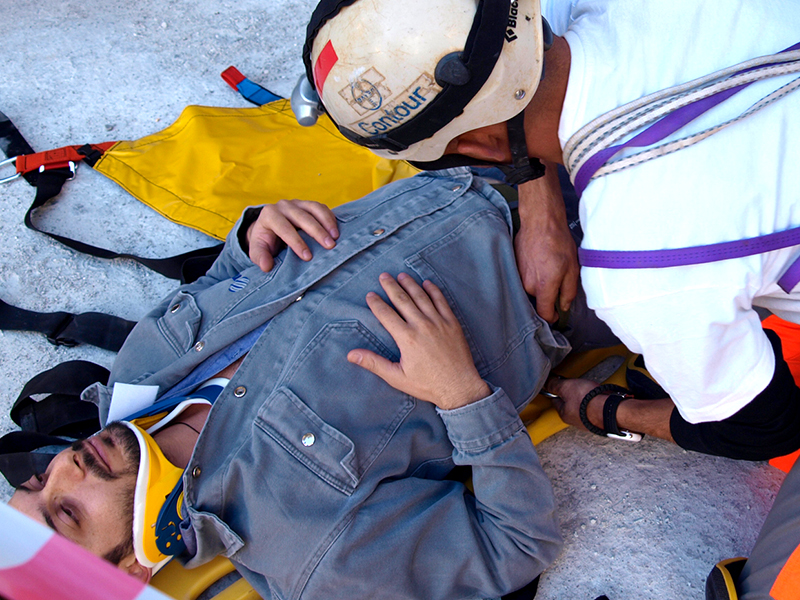- 10) Be able to administer First Aid to a casualty with suspected chest injuries.
Recognise the different types of chest injury – Administer first aid for a chest injury - 11) Emergency Moves.
Understand when and when not move a casualty – Learn How to move a casualty in an Emergency - 12) Be able to conduct a secondary survey.
Illness assessment – Points and Symptoms for illness -Performing a physical assessment from head to legs - 13) Be able to administer First Aid to a casualty with burns and scalds.
Be able to administer First Aid to a casualty with burns and scalds. – Administer first aid for burns involving: *dry heat *wet heat *electricity *chemicals - 14) Be able to administer First Aid to a casualty with an eye injury.
Give examples of common eye injuries. – Administer first aid for eye injuries involving: *dust *chemicals *embedded objects - 15) Be able to administer First Aid to a casualty with sudden poisoning.
Identify the routes that poisons can take to enter the body. – Administer immediate first aid to a casualty affected by sudden poisoning. - 16)Be able to administer First Aid to a casualty with anaphylaxis
Identify common triggers for anaphylaxis – Recognise anaphylaxis – Administer immediate first aid for a casualty suffering from anaphylaxis. - 17) Be able to recognize a serius illness
Recognise major illnesses including: *heart Attack *stroke *epilepsy *asthma *diabetes – Administer first aid to a casualty suffering from major illnesses including: *heart Attack *stroke *epilepsy *asthma *diabetes
157A G.S. RAKOVSKI STR. SOFIA
Please provide "Instagram App" settings to proceed.

First aid at work
FAaW
- 1) Understand the role and responsibilities of a first aider
The role of a first aider - 2) Be able to assess an incident.
Personal safety – Personal safety exercises – Using barriers – Call for help - 3) Be able to manage an unresponsive casualty who is breathing normally.
Level of consciousness – Open an airway – check breathing – Complete Initial Assessment – Who to Place in the recovery position, an who not to – Place someone in the recovery position, practice – Clear solid material and fluids from the airway - 4) Be able to manage an unresponsive casualty who is not breathing normally.
Cardio Pulmonary Resuscitation – Ventilations practice – Chest compressions practice – Cardio Pulmonary Resuscitation practice – Chain of survival - 5) Be able to recognise and assist a casualty who is choking.
Describe how to identify a casualty with a: *partially blocked airway *completely blocked airway – Administer first aid to a casualty who is choking. - 6) Be able to manage a casualty with external bleeding.
Identify the types of external bleeding. – Control external bleeding – Control external bleeding practice - 7)Be able to manage a casualty who is in shock.
Recognise shock. – Administer first aid to a casualty who is in shock. - 8) Be able to recognize a serius illness
Signs and Symptoms for serious illness – Recognize and manage Breathing Difficulty or Shortness of Breath – Recognize and manage Pain, Servere Presure or Discomfort in Chest – Recognize and manage Severe Abdominal Pain – Recognize and manage Altered Level of Responsiveness - 9) Be able to administer First Aid to a casualty with suspected head, neck and spinal injuries.
Identify a major mechanism of injury – Identify and manage a Head injury – Identify and manage a Neck injury – Identify and manage a spinal injury – Identify and manage a Deformed Limb
Certification Period
2 Years
Course Length
18 Hours
Student / Instructor Ratio
(Recommended/Maximum)
6:1 / 12:1
Student / Equipment Ratio
(Recommended/Maximum)
1:1 / 3:1
_____________________________________
Class Delivery Types
![]() Blended Learning with In-Person, Instructor-Led Skills Session
Blended Learning with In-Person, Instructor-Led Skills Session
____________________________________